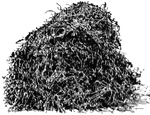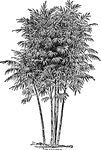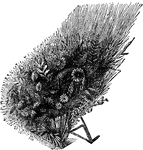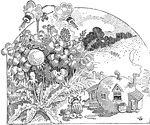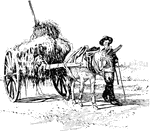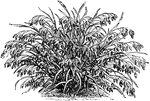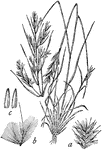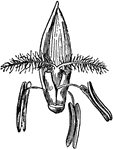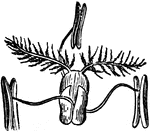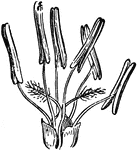
Agrostis Nebulosa
The common name of Agrostis nebulas is cloud grass. The grass grows one foot tall.
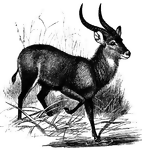
Kobus Sing-Sing Antelope
"A West-African kob antelope, Kobus sing-sing. —Whitney, 1889 This illustration shows the antelope…
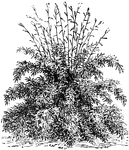
Arundinaria Falcata
Arundinaria falcata grass is very light green. The leaves are linear and narrow. The stems are deep…

Bamboo
"A genus of grasses, of which most of the species attain a great size, many of them 20 or 30 feet, some…
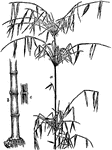
Bamboo
"Bamboo. a.- upper portion of the stem with foliage. b.- root stem. c.- section of stem. Bamboo, the…
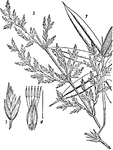
Indian Bamboo
"Bambusa arundinacea, in Indian bamboo. 1. Leafy shoot. 2, Branch of inflorescence. 3, Spikelet.…
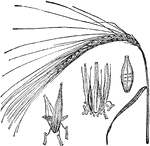
Barley
"Barley, the name of several cereal plants of the genus Hordeum, order Gramineae (grasses), yielding…

Swiss Moss Basket
"The Swiss Moss Baskets, filled with Flowers and Grasses, are very neat for setting on the table or…
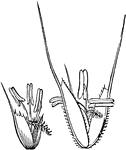
Annual Beard Grass
"5. locusta of Polypogon monspeliensis; 6. paleae, &c. of the same." -Lindley, 1853
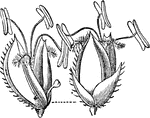
Bermuda Grass
"9. locusta of Cynodon dactylon; 10. paleae, and abortive floret of the same." -Lindley, 1853
Canada blue-grass
Canada blue-grass, also known as wire-grass. Suitable for soils too poor to support Kentucky blue-grass.

Habit and Single Flower of Briza Maxima
Each spikelet of briza maxima has thirteen to seventeen flowers. The stem nods at the end. The flowers…

Habit and Small Panicle of Flowers of Briza Minor
The common name of briza minor is Little Quaking Grass. The spikelets are triangular and seven flowered.…

Bulrush
"Scirpus lacustris. 1. A flower surrounded with hypogynous bristles; 2. a seed; 3, a section of it,…

Bulrush
"1. Flowering plant of Bulrush (Scirpus lacustris). 2. The inflorescence. a, a flower; b, the fruit."…

Bulrush
A bulrush, part of the sedge family, common on borders of salt and fresh ponds and streams, Scirpus…

Common Bulrush
"Typha latifolia; 2, its fruit; 3, a section of the seed; 4, the embryo; 5, a stamen." -Lindley, 1853
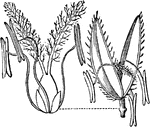
Rice Cutgrass
"3. paleae of Leersia oryzoides; 4. pistil, stamens, and hypogynous scales of the same." -Lindley, 1853
Darnel
"A grass of the same genus with the valuable Ryegrass, an annual, common in the cornfields in England…
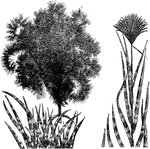
Foliage, Fully Expanded, and Young Inflorescences of Eulalia Japonica Zebrina
Eulalia is a hardy, ornamental grass. Eulalia japonica zebrina has leaves with bars of yellow running…

Nests of the genus Euplectes
Woven of grass, the nests of the genus Euplectes have an opening which faces down towards the water.…

Farmhouse
A well-planted farmyard, with trees at the sides, flowers in the corners and about the house, and an…
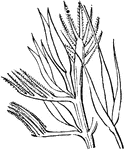
Feather Grass and Crested Dog's-Tail
"7. locusta of Stipa pennata" (Feather Grass); "8. rachis, bracteae, and florets of Cynosurus cristatus"…
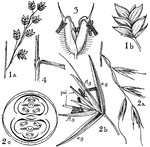
Gramineae Order
Gramineae order consists of the grass family. Pictured are (1a) a part of a grass panicle, (1b) spikelet,…

Grass Flower
"Graminae. Flower of a Grass, the glumes are removed. GRAMINAE. In botany, the largest order among endogenous…

Grass Flower
"Graminae. Flower of a Grass. GRAMINAE. In botany, the largest order among endogenous plants except…

Annual Spear Grass
Spear grass is a herbaceous grass often troublesome in gravel walks and on hard, dry soils. The general…
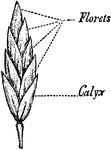
Annual Spear Grass
Spear grass is a herbaceous grass often troublesome in gravel walks and on hard, dry soils. The general…
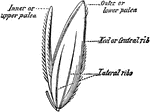
Annual Spear Grass
Spear grass is a herbaceous grass often troublesome in gravel walks and on hard, dry soils. The general…
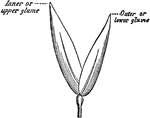
Annual Spear Grass
Spear grass is a herbaceous grass often troublesome in gravel walks and on hard, dry soils. The general…

Annual Spear Grass
Virginia Cut Grass (Leersia Virginica) is a small flowered white grass, and is smoother than white grass…
Barley
Barley is a cereal grain derived from the annual grass Hordeum vulgare, a common barley. It serves as…

Barley
Barley is a cereal grain derived from the annual grass Hordeum vulgare, a common barley. It serves as…
Beach Grass
Beach Grass (Calamagrostis arenaria or Ammophila arundinacea), also known as Seasand Reed and Mat Grass,…
Bearded Darnel
The Bearded Darnel (Lolium temulentum) is sometimes found in grain-fields, with its glume equalling…
Black Oat Grass
Black Oat Grass (Stipa avenacea) is found in dry, sandy woods and has no agricultural value. It grows…

Black Oat Grass
Black Oat Grass (Stipa avenacea) is found in dry, sandy woods and has no agricultural value. It grows…
Chess Grass
The Chess Grass (Bromus secalinus), also called Willard's Bromus, has a spreading, slightly drooping…
Chess Grass
The Chess Grass (Bromus secalinus), also called Willard's Bromus, has a spreading, slightly drooping…

Chess Grass
The Chess Grass (Bromus secalinus), also called Willard's Bromus, has a spreading, slightly drooping…
Chess Grass
The Chess Grass (Bromus secalinus), also called Willard's Bromus, has a spreading, slightly drooping…

Chinese Sugar Cane
The stem of Chinese Sugar Cane (Sorghum nigrum), also known as Sorgho, or Sorgho Sucre, rises from six…

